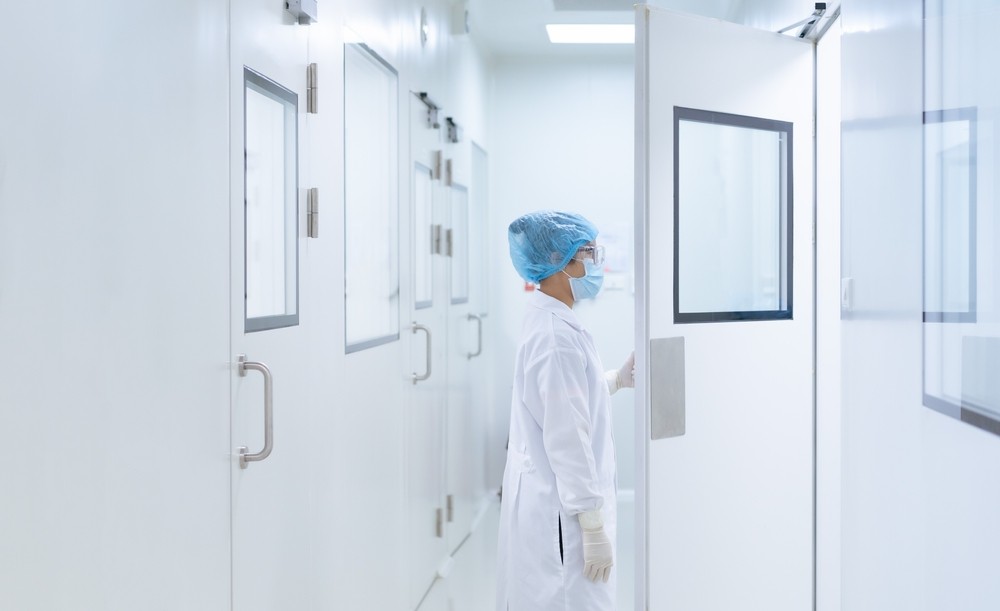
Cleanroom Terminology: What Is an Airlock?
When entering the world of cleanroom design, many people are overwhelmed by the new vocabulary, which can be quite complicated. Suddenly, you have to understand classifications and all sorts of design features and figure out which are right for your application.
We’re here to break down one of the most common terms you’ll hear in cleanroom design – airlocks. So, what is an airlock, and how does an airlock work? Let’s get jump in.
What Is an Airlock?
An airlock is a system of two doors that are electronically interlocked so that both cannot be opened at the same time. This prevents contamination and prevents particles from outside the cleanroom from entering the cleanroom when personnel enter or exit the cleanroom.
In addition to its role in contamination control, airlocks can serve as security features, controlling and monitoring access to the cleanroom. An airlock system will also help maintain the controlled temperature of a cleanroom space. They are vital components in various industries, adapting to specific cleanroom requirements while offering emergency features to ensure personnel safety.
How Does an Airlock Work?
An airlock creates a controlled, enclosed space with two interlocked doors. They make a controlled transitional space between an external environment and a cleanroom, with the primary goal of preventing contamination, maintaining cleanliness, and preserving the specified environmental conditions within the cleanroom.
Here’s how airlocks typically operate:
- Two-Door System: An airlock consists of two doors, one leading to the outside environment and the other to the cleanroom. These doors are electronically interlocked, ensuring that both doors cannot be opened simultaneously.
- Pressure Differential: The cleanroom typically operates at a higher pressure than the surrounding area. When personnel need to enter or exit the cleanroom, they first enter the airlock. The outer door is closed behind them, sealing off the outside environment.
- Controlled Environment: Once inside the airlock, the system may initiate a series of processes to maintain the controlled environment. This can include adjusting temperature, humidity, and pressure levels to match the cleanroom’s specifications.
- Personnel Procedures: Personnel inside the airlock may need to follow specific procedures, such as donning cleanroom attire, which includes specialized garments, headgear, and shoe covers.
- Interlocking Doors: After the necessary preparations and checks are completed inside the airlock, the inner door can be opened. This allows personnel to enter the cleanroom while ensuring that the outer door remains closed, maintaining the pressure and cleanliness of the cleanroom.
- Security Features: Some airlocks include security features like access control systems to authenticate and authorize individuals.
What Kinds of Airlocks Are There?
There are two types of airlocks: secure and non-secure airlocks. In a secure airlock system, all doors remain locked until a request to enter is granted. This generally occurs through a “request to enter device,” like a button or keypad. A non-secure airlock means that the doors remain unlocked until the first door is opened; then, the other doors lock.
You also have the option of making your airlocks supervised or unsupervised. For high-security areas, you may have a supervised airlock, where personnel must press a “request to access” button. The request must be approved via a CCTV or viewing panel verification system.
An unsupervised cleanroom could control access through a biometric reader or keypad to gain access. Such systems are useful where only authorized personnel may enter the cleanroom environment.
Enhancing Cleanroom and Airlock Security
Depending on the classification and application of your cleanroom, you might want additional security features in place on your airlock. These considerations aim to enhance security and monitoring within the airlock system to minimize the risk of contamination and maintain the pristine conditions of the cleanroom.
- Breach Alarms: Depending on the sensitivity and cleanliness requirements of the cleanroom, it may be essential to implement breach alarms within the airlock system. These alarms serve as a critical safeguard, alerting personnel when the airlock has been breached. Breach alarms are triggered when unauthorized access or contamination may have occurred.
- Door Open Duration Alarms: Cleanrooms often require swift and controlled access, and extended open-door times can compromise the cleanliness and environmental conditions. Door open duration alarms provide a mechanism to ensure that doors are not left open for too long, thereby preventing prolonged exposure of the cleanroom to the outside environment.
- Door Status Indicators: Door status indicators are visual or electronic displays that provide real-time information about the current state of the airlock doors. These indicators offer a quick and easy way for personnel to confirm whether the outer door is securely closed before opening the inner door.
Cleanrooms to Fit All Your Needs From Angstrom Technology
If your cleanroom requires an airlock, Angstrom Technology is well-equipped to design a custom cleanroom that perfectly aligns with your specific needs. Our team of seasoned design engineers possesses the knowledge and expertise required to create a cleanroom solution tailored to your industry’s unique cleanliness standards and environmental demands.
Contact Angstrom Technology today, and let’s embark on the journey towards a tailored cleanroom solution that precisely fits your requirements, enhancing your controlled environment for optimal operations.
